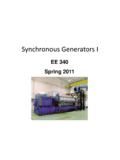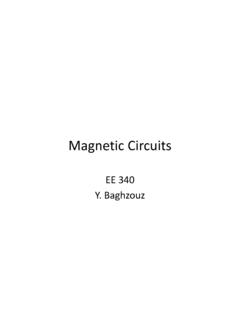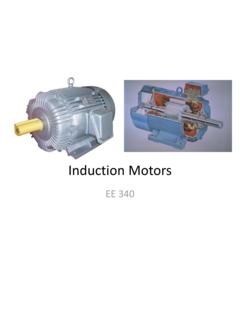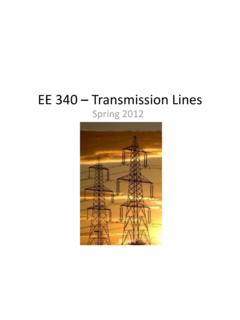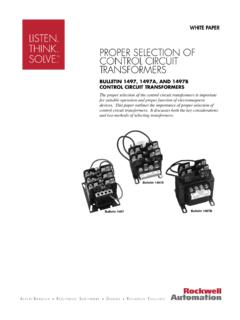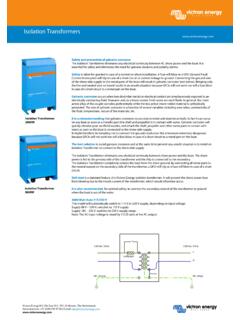Transcription of Diode Rectifiers - UNLV
1 5-1 Diode Rectifiers EE 442-642 5-2 Half-Bridge Rectifier Circuit: R and R-L Load current continues to flow for a while even after the input voltage has gone negative. 5-3 Half Bridge Rectifier Circuit: Load with dc back-emf current begins to flow when the input voltage exceeds the dc back-emf. current continues to flows for a while even after the input voltage has gone below the dc back-emf. 5-4 Full-wave Rectifier with Center tap Transformer The DC currents of the two half- wave Rectifiers are equal and opposite, Hence, there is no DC current for creating a transformer core saturation problem.
2 Each Diode carries half of the load average current , but the same peak load current . Note that the VRRM rating of the diodes must be chosen to be higher than 2Vm to avoid reverse breakdown. The center-tap transformer is considered bulky with additional losses. 5-5 Full Bridge Rectifier Simple R Load Average value of output voltage: where Vs and Vm are the RMS and peak values of input voltage. Rectification Ratio = Pdc/Pac = or 81% Form Factor (FF) of DC side voltage (or current ) = Vrms/Vdc = Ripple Factor = rms value of AC component/DC component = (FF2-1)1/2 = )/2( )/22( 5-6 Filters Filters are employed in rectifier circuits for smoothing out the dc output voltage of the load.
3 Ripple Reduction Factor at fr: 5-7 Inductor DC Filter Minimum value of inductance required to maintain a continuous current is known as the critical inductance LC: The choice of the input inductance depends on the required ripple factor . Ripple voltage of a rectifier without filtering: Considering only the lowest-order harmonic (n = 2), the output ripple factor of a simple inductor-input dc filter is 5-8 Full Bridge Rectifier with dc-side Voltage Zero current corresponds to dc voltage equal to the peak of the input ac voltage Average value of DC-side current (obtained numerically): 5-9 Full Bridge Rectifier Simple Constant Load current ]1)8/([100.
4 7,5,3, )/22(211 PFDPFTHDhhIIIIIII sshddsds RSM value of source current RMS value of fundamental current RMS value of harmonic current current THD Displacement Power Factor Power Factor 5-10 Full Bridge Rectifier Simple Constant Load current (AC-side filtering) RMS value of harmonic source current THD of Source current : 5-11 Diode -Rectifier with a Capacitor Filter Approximate value of peak-to-peak ripple: Average output voltage: RMS value of output ripple voltage: Ripple Factor: inrush resistance Rinrush is sometimes needed to limit the initial inrush current to a value below that of the diodes.
5 It is usually placed on the DC side, then shorted out afterwards. In many cases, Rinrush is not needed if the Equivalent Series Resistance of the capacitor and cable/transformer wire resistance are sufficiently large. 5-12 Diode -Rectifier Bridge with AC-Side Inductance Commutation angle: Average of DC-side voltage: 5-13 Voltage Distortion at PCC PCC is the point of common coupling Distorted current flow results in distorted voltage 5-14 Dual Voltage Rectifier In 115-V position, one capacitor at-a-time is charged from the input.
6 5-15 Three-Phase, Four-Wire System A common neutral wire is assumed The current in the neutral wire is composed mainly of the third harmonic and can be higher than the phase currents 5-16 3-Phase Rectifier Circuit Star Connection: direct currents in the secondary windings cause transformer core saturation problem. The transformer core saturation problem in the three-phase star rectifier can be avoided by zig-zag (or inter-star) connection. Three-phase Bridge (or 6-pulse) Rectifier most commonly used in industry applications.
7 5-17 Three-Phase Bridge Rectifier with R Load Average value of DC-side voltage: where Vm is the peak value of the phase voltage. RMS value of DC-side voltage: 5-18 Six-Phase Bridge Rectifier (12-Pulse) Average and RMS values of DC-side voltage: where Vm is the peak value of the phase voltage. 5-19 Three-Phase Full-Bridge Rectifier with DC current 5-20 Three-Phase, Full-Bridge Rectifier with DC current RSM value of source current RMS value of fundamental current RMS value of harmonic current current THD Displacement Power Factor Power Factor ]1)9/([100.
8 7,5,3, )/6( PFDPFTHDhhIIIIIIII sshddsdds5-21 3-Phase, Full-Bridge Rectifier with Inductance Commutation angle: Average of DC-side voltage: 5-22 3-Phase Rectifier with DC Source 5-23 Three-Phase Rectifier with Capacitor Filter PSpice-based analysis

